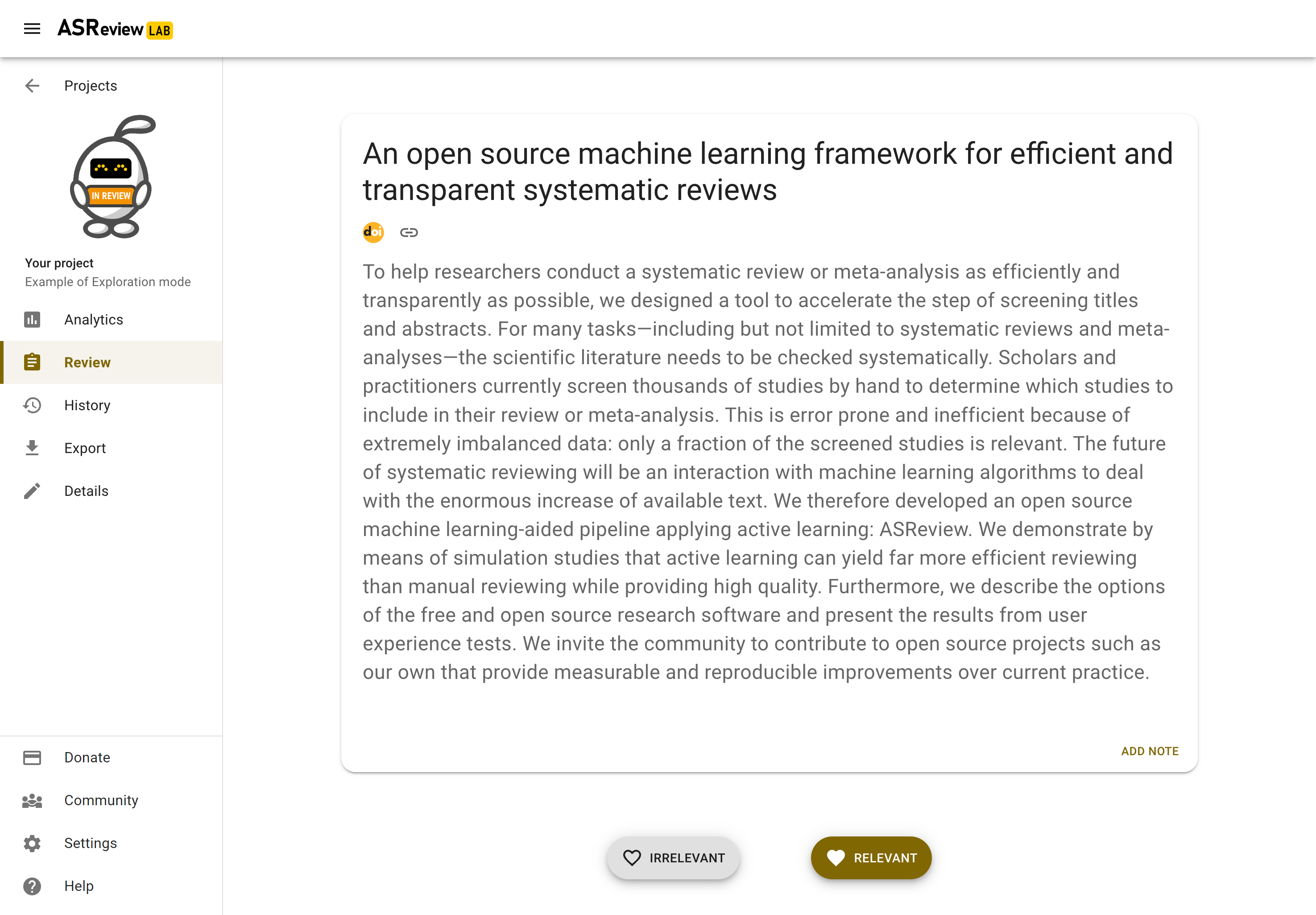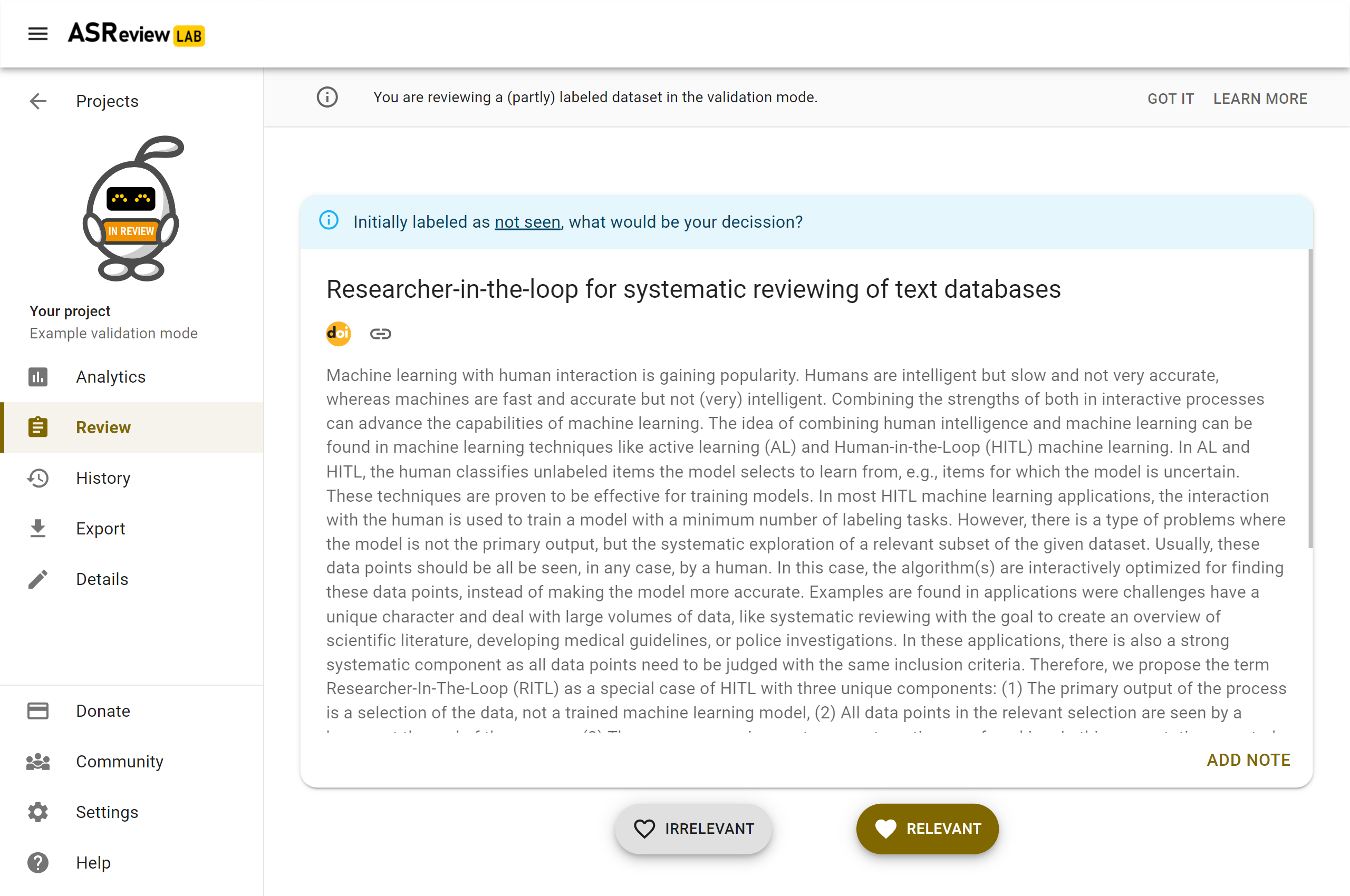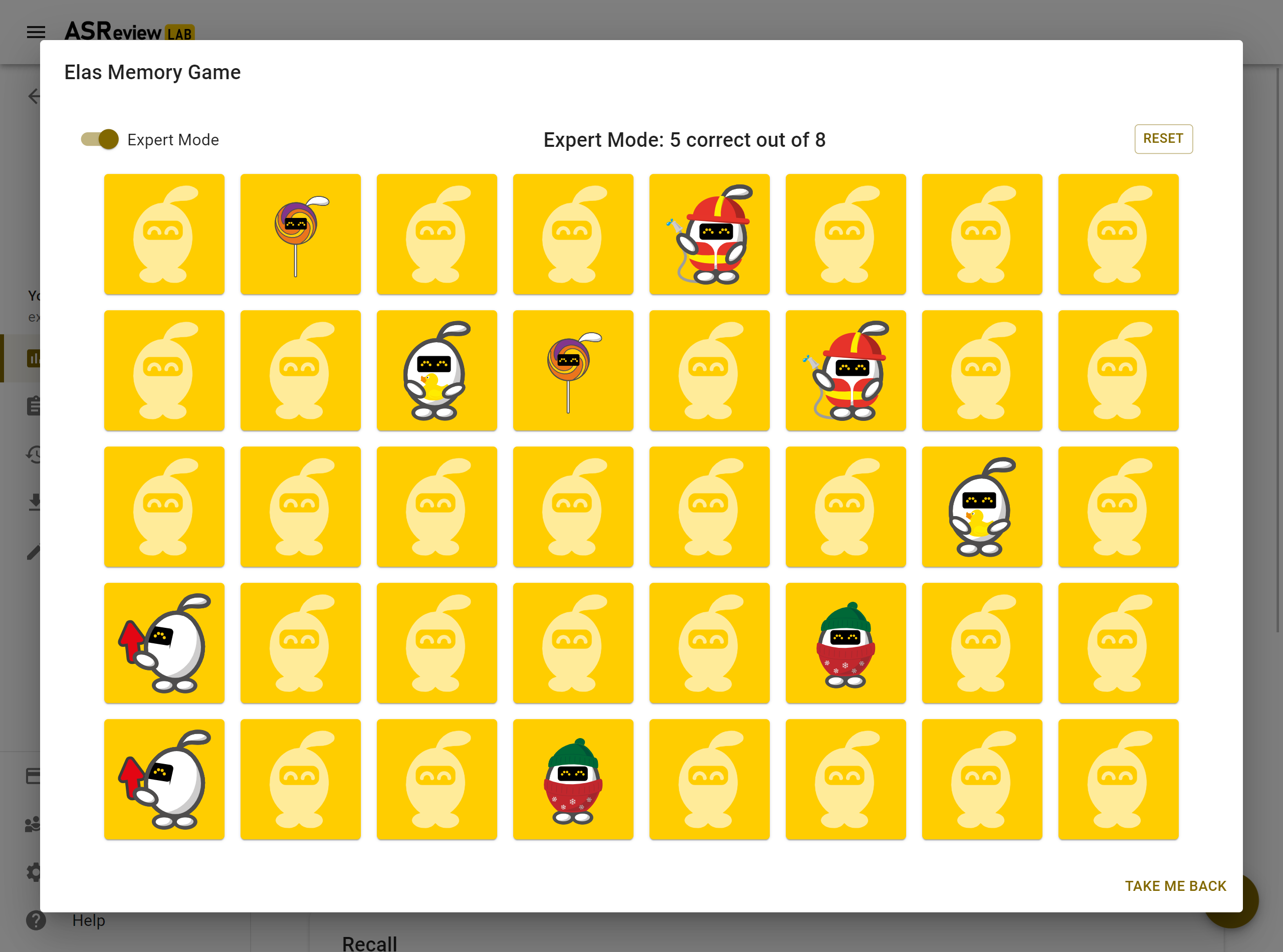Screening
Note
Only for Oracle and Validation. Read more about the options for the Simulation mode in the Overview.
Introduction
As soon as your project is initiated, you can start reviewing. Click on Review in the left menu if your project is not on the review page yet. ASReview LAB presents you a title and abstract to screen and label.
You are asked to make a decision: relevant or irrelevant?

Screening in Oracle mode
In the Oracle mode, unlabeled records are presented to you. Depending on the selected strategy it is the most likely relevant record (default setting) or based on another:ref:project_create:Query Strategy.
Click on the decision of your choice, and a new record is presented to you. While you review the next record, a new model is being trained. ASReview LAB continuously improves its understanding of your decisions, constantly updating the underlying ordering of the records.
Each labeling decision of the user starts the training of a new model given no model is being trained at that time. When this new model is trained, the unseen records’ rank order is updated. Training and labeling occur asynchronously. With fast models, a new ranking will probably be available before the user finishes reading the text. With slower models, training continues until a new model is trained, and the user can continue screening the next record in line (2nd, 3rd, etc.). Therefore, the record shown to the user can be the one with the highest relevance score of the second last model or the highest-ranked as a result of the latest model until a new model is trained. For a detailed description of the the data model, see the paper Reproducibility and Data Storage Checklist.
As you keep reviewing documents and providing labels, you will probably see fewer relevant records. When to stop screening is left to you. See Progress and results for more information on progress monitoring and information on when to stop.
Tip
If you are in doubt about your decision, take your time as you are the oracle. Based on your input, a new model will be trained, and you do not want to confuse the prediction mode. For the model, it may be better to consult others, and read the full text (in case of reviewing abstracts of scientific papers)
Screening in Validation mode
The Validation mode (formerly known as Exploration mode) is tailored for scenarios where it’s necessary to validate existing labels or engage in a review process without being an oracle. This mode is especially beneficial for validating labels made by a first screener, reviewing labels predicted by Large Language Models(LLMs) such as ChatGPT, or for educational and training purposes.
In this mode, records are presented along with an indication of their previous labeling status: relevant, irrelevant, or not seen. This status is displayed via a color-coded bar above each record. If a record was labeled by another screener or an AI model, you have the opportunity to validate, or challenge these labels, helping to refine the dataset by correcting any potential misclassifications, useful for the quality evaluation of the SAFE procedure.
Additionally, the Validation mode is useful for educational use. Instructors and learners can utilize this mode to simulate the screening process without being the expert decision-maker. This setup is particularly advantageous in workshop settings, where participants can engage with the screening process using the labeled SYNERGY datasets. This hands-on experience offers valuable insights into the software’s functionality and the systematic review process without the need to be a content expert. For comprehensive online teaching materials and tutorials on using ASReview LAB effectively, please visit the ASReview Academy.

Autosave
Your decisions (and notes) are saved automatically into your ASReview project file. There is no need to press any buttons to save your work anywhere in ASReview LAB (in fact, there is not even a save button).
Change decisions
In some cases, you might want to change your previous decision. The screening interface of ASReview LAB offers two options to change your decision.
Undo last decision
You can return to your previous decision during screening.
Open or Create a project.
Label the record displayed in the screen as relevant or irrelevant.
Click on Undo (At the bottom right)
Click on Keep (ir)relevant or Convert to (ir)relevant.
Continue screening.
You can disable this option in the Settings menu.
Screening history
An overview of your decisions made during screening can be found on the History page. You can change decisions on this page.
Open or Create a project.
Click on History in the menu on the left.

Changing decisions on the history page
To change a label of a record, click the heart icon. The next iteration of the model will take the new label into account.
Full Text
If a column with Digital Object Identifiers (DOI) or URLs is available in the metadata of your dataset, ASReview LAB will display the DOI and URL during screening. Most of the time, DOIs point to the full-text of a publication. See datasets for more information on including DOI and URL values to your datasets.
Keyboard shortcuts
ASReview LAB supports the use of keyboard shortcuts during screening. The table below lists the available keyboard shortcuts.
You can press a key (or a combination of keys) to label a record as relevant or irrelevant, or to return to the previous decision during screening. By default, keyboard shortcuts are disabled.
Action |
Shortcut |
|---|---|
Label record as relevant |
r or Shift + r |
Label record as irrelevant |
i or Shift + i |
Return to previous decision |
u or Shift + u |
Note
Keyboard shortcuts are only available when the Undo feature has been enabled in the Settings (bottom left).
Display
Dark mode
ASReview LAB offers the option to customize the screening appearance and functionality.
Click on Settings (bottom left).
Go to Display and toggle the dark mode
Note
Your preference is saved in the browser.
Font size
You can make the text on the review screen smaller or larger.
Click on Settings (bottom left).
Go to Display and click on Font size.
Slide the slider to the desired font size.
ELAS Memory Game
If you want a break from screening, you can search for the hidden ELAS memory game.

If you really need a long break, try the expert mode.
